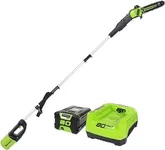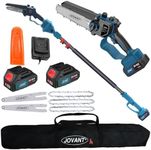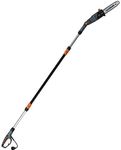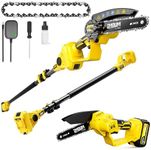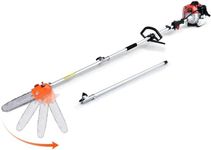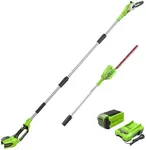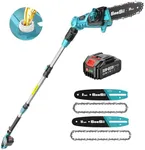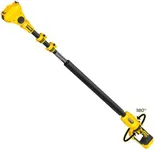Buying Guide for the Best Pole Chainsaws
Choosing the right pole chainsaw can make a significant difference in your gardening and landscaping tasks. A pole chainsaw is essentially a small chainsaw attached to an extendable pole, allowing you to trim and prune trees and branches that are out of reach without the need for a ladder. When selecting a pole chainsaw, it's important to consider several key specifications to ensure you get the best fit for your needs. Understanding these specifications will help you make an informed decision and choose a tool that is both effective and safe for your intended use.Power SourceThe power source of a pole chainsaw determines how the tool is powered and can significantly impact its performance and convenience. There are three main types: gas-powered, electric (corded), and battery-powered (cordless). Gas-powered pole chainsaws are typically the most powerful and are suitable for heavy-duty tasks, but they are also heavier, noisier, and require more maintenance. Electric corded models are lighter and quieter, with unlimited run time as long as they are plugged in, but their range is limited by the length of the power cord. Battery-powered models offer the most convenience and mobility, being lightweight and easy to maneuver, but their run time is limited by battery life. Choose a power source based on the size of your yard, the type of tasks you need to perform, and your preference for mobility and maintenance.
Bar LengthThe bar length of a pole chainsaw refers to the length of the cutting blade and determines the maximum diameter of branches it can cut. Bar lengths typically range from 6 to 12 inches. Shorter bar lengths (6-8 inches) are suitable for light pruning and trimming of smaller branches, making them ideal for residential use. Medium bar lengths (8-10 inches) offer a balance between maneuverability and cutting capacity, suitable for medium-sized branches. Longer bar lengths (10-12 inches) are designed for cutting thicker branches and more demanding tasks. Consider the types of trees and branches you will be working with to choose the appropriate bar length.
Pole LengthThe pole length of a pole chainsaw determines how high you can reach with the tool. Pole lengths can vary from around 8 to 15 feet. Shorter poles (8-10 feet) are easier to handle and control, making them suitable for lower branches and smaller trees. Medium poles (10-12 feet) offer a good balance of reach and control, suitable for most residential tasks. Longer poles (12-15 feet) provide maximum reach for tall trees and high branches but can be more challenging to maneuver. Assess the height of the trees and branches you need to trim to select the right pole length for your needs.
WeightThe weight of a pole chainsaw affects how easy it is to handle and use for extended periods. Lighter models (under 10 pounds) are easier to maneuver and cause less fatigue, making them ideal for smaller tasks and users who may not have a lot of upper body strength. Medium-weight models (10-15 pounds) offer a balance between power and ease of use, suitable for most residential tasks. Heavier models (over 15 pounds) are typically more powerful and durable but can be more tiring to use for long periods. Consider your physical strength and the duration of your tasks when choosing the weight of your pole chainsaw.
Safety FeaturesSafety features are crucial in a pole chainsaw to prevent accidents and injuries. Common safety features include anti-kickback chains, chain brakes, and automatic oilers. Anti-kickback chains reduce the risk of the chainsaw kicking back towards the user, while chain brakes stop the chain immediately if kickback occurs. Automatic oilers ensure the chain is properly lubricated, reducing the risk of overheating and malfunction. Look for models with these safety features to ensure safe operation, especially if you are a beginner or will be using the tool frequently.
Ease of MaintenanceEase of maintenance is an important consideration to ensure the longevity and performance of your pole chainsaw. Features such as tool-less chain tensioning, easy access to the air filter and spark plug (for gas models), and automatic oilers can make maintenance tasks simpler and quicker. Regular maintenance includes checking and adjusting the chain tension, cleaning the air filter, and ensuring the chain is properly lubricated. Choose a model with user-friendly maintenance features to keep your pole chainsaw in good working condition with minimal effort.

